Learning how to start a lifestyle blog can be life-changing for you. Not only would you have the opportunity to share your life experiences, passions, and insights, but you’d also get to learn a lot from your readers. After all, many blog readers enjoy sharing their own takes on specific topics and discussions – that’s just one of many reasons why it can be enlightening to make a blog.
Of course, running lifestyle blogs can be quite a lucrative endeavor as well, whether you’re doing it as a hobby or planning to make it your primary source of income.
But, you have to do it right. Luckily, it’s much easier than you may think. With some guidance and dedication, you’ll master the art of blogging in no time, and we’ll help you every step of the way.
So, check out this thorough guide on how to start a lifestyle blog for beginners. It’s divided into eight easy-to-digest steps that’ll help you become a pro.
⏳ Short on Time? → Click Here for a Quick Start with Bluehost
Table of contents
- Step #1: Decide on your niche
- Step #2: Select your blogging platform
- Step #3: Name your blog
- Step #4: Get hosted
- Step #5: Launch your blog on WordPress
- Step #6: Set the theme
- Step #7: Publish and promote
- Step #8: Turn a profit
- Takeaway
Step #1: Decide on your niche
Whether you’re wondering how to start a lifestyle blog on Instagram or any other platform, the first step is always the same. You need to come up with your unique selling point. And this starts with determining your niche.
Simply “lifestyle” is a broad topic that will make it difficult for your blog to stand out among countless others. Today, there are well over 600 million blogs online. Learning how to start a lifestyle blog in 2024 is quite different than it was in the early days of blogging.
In 2010, for example, you could’ve succeeded with a very general topic as a blogger. A decade later, and you need to have a very specific niche to move forward and stand out.
With a suitable niche and a narrower focus, you’ll have an easier time coming up with relevant topics, attracting your target audience, and outperforming direct competitors. Overall, you’ll simplify your blogging experience by making a smart choice now.
How to find your lifestyle blog niche?
Most blogging beginners experience some challenges finding a suitable niche. However, it doesn’t have to be all that difficult. You simply need to answer a few questions:
- What are your skills and interests?
You cannot hope to learn how to start a lifestyle blog and make money from it if you have no interest in it. You’ll likely spend years working on your blog, promoting it, gathering readers, and more. So, if you’re not skilled or passionate about the topic of your choosing, running your blog will become an exhausting chore. Narrow down your lifestyle niche by focusing on your own skills and interests, the latter perhaps being more important. If you are interested in something, you’ll find it much easier to level up your relevant skills. Your passion for the topic will push you forward and help you to stay inspired and focused. - Who is your target audience?
Answering this question will help you to develop a unique brand persona, tone of voice, and general approach to blogging. Think very carefully about who your target audience is. What are their hobbies, interests, and personalities? Is your ideal reader a college student or perhaps a businessperson? How old are they and where do they live? Are they affluent individuals or struggling artists? Be very specific about your target readers. You can go so far as to envision a specific person with a specific name. “My reader is Emma. She’s 28 years old, works at a marketing company, and lives in Boston. She likes cooking and spending time with her pet French bulldog.” When you have a specific target reader in mind, you’ll find it easier to write and express yourself in a way that would appeal to them. If your actual readers swerve away from what you’ve envisioned, you can easily adapt your approach to suit them. - Why would your target audience be interested in reading your blog?
Finally, you’ll need to think about why your target readers might be interested in your lifestyle blogs. Do you have something of value to offer them? Some unique insights and information? Can you perhaps solve some of the problems that your readers are likely to encounter?
The best lifestyle blogs will have a unique selling point that’s appealing to their target audience, and that piques their interest. You’ll have no trouble coming up with a relevant niche once you’ve answered these three crucial questions.
Commonly covered topics on lifestyle blogs
Of course, you can also find a suitable niche by checking out some of the most common lifestyle topics:
- Beauty
- Self-Care
- Fashion
- Health & Fitness
- Motherhood
- Family
- Food
- Hobbies
- Home Decor
- Travel
Since these are the most common lifestyle blog topics, you’ll find fierce competition there. So, if any of these topics resonate with you, be sure to give them an interesting twist or provide a different perspective.
Step #2: Select your blogging platform
Some web development skills can be quite useful when you’re figuring out how to start a lifestyle blog. But, you don’t have to spend years learning how to code. All you need is a reliable blogging platform. It will enable you to easily manage, publish, and edit the content on your site, without any prior programming knowledge.
You have several ready-made blog sites and content management systems at your disposal such as WordPress, Wix, Squarespace, etc.
Regardless of which blogging platform you choose, you’ll have to decide whether you want free web hosting or an open-source self-hosted blog.
Free web hosting
Free web hosting is exactly what it sounds like – a free service that provides you with the tools to launch your website. The best examples of free web hosting platforms are WordPress.com and Blogger.com.
You’ll get access to all of the basic features, themes, gadgets, and templates, but there are a few drawbacks.
While you can choose the name for your lifestyle blogs, your domain name would appear as [yourwebsitename].wordpress.com or [yourwebsitename].blogspot.com. If you want to choose your domain name or use any advanced features, you’ll need to upgrade.
Going for the free web hosting option will also bring some other limitations. You’ll have limited storage, sub-optimum bandwidth allocation, and you’ll have no say in ad choice and placement. Overall, it’s not the best option, but it can be a good place to start.
Open-source self-hosted blog
An open-source self-hosted blog is a much better alternative. You’ll have full control over your blog, and you can customize it however you like – choose your domain name, decide on ad placement (if you want ads at all), get all of the plugins you need, enjoy better back-up, and marketing.
We highly recommend using the self-hosted setup and our top recommendation is WordPress.org due to its abundance of features. Your WordPress blog will be easily customizable. You can add high-quality media, download thousands of useful plugins, and try so many free themes.
When creating a self-hosted WordPress lifestyle blog, you’ll have to choose your hosting provider, and of course, your domain name. The best hosting provider, by far, is Bluehost. It powers over 2 million websites and is an excellent option for beginners and pros alike.
I was able to negotiate a special deal only for my visitors that includes:
- Free domain name
- Discount price of $2.75 per month
- 30-day money-back guarantee period
→ Click Here to Claim an Exclusive 65% Bluehost Discount Offer ←
Step #3: Name your blog
While the name isn’t the most important aspect of your lifestyle blogs, it’s still necessary to think carefully about it. After all, it’s likely the first thing your readers will notice, so you want it to act almost like your brand ambassador.
Keep the name:
- Short and sweet
- Memorable
- Unique
- Easy to spell and pronounce
It needs to resonate with your audiences, so make sure to pick a good blog name.
The annual price for a name typically goes between $10 and $15 per .com domain. Our favorite domain hosting service for lifestyle blogs is Bluehost. You can choose your domain name for free, use one you already have, or simply come up with one later, just before you launch your blog.
Recommended tool:
Step #4: Get hosted
Lifestyle blogs don’t simply float around in the ether. Everything that exists on the internet needs to be stored on a server so that it’s accessible for viewing at any time. Since it’s generally difficult (and not to mention expensive) to create your own servers, you need to outsource your hosting needs.
Web hosting enables you to rent or buy a space where you’ll house your blog. You’ll get access to servers, data centers, and accompanying services that allow your blog to live online and be connected to the internet.
The best web hosting provider that is even recommended by WordPress is Bluehost.
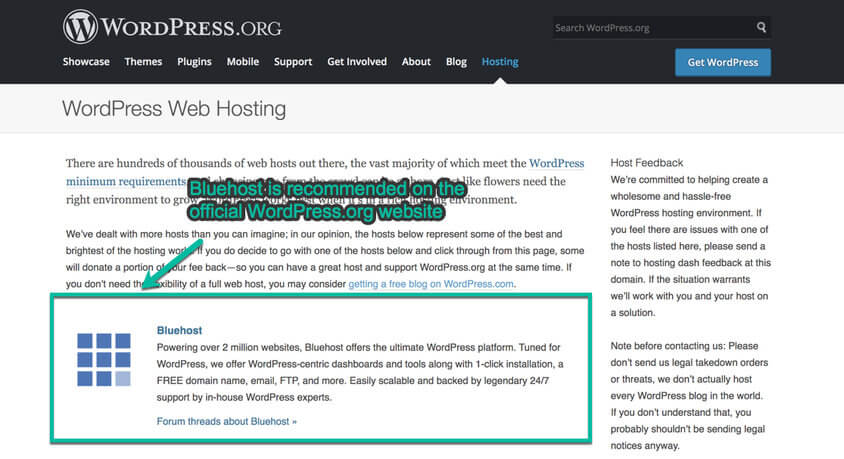
It offers a free domain name in the first year when you buy their services and a thirty-day money-back guarantee.
Our readers can get a special discount offer and use Bluehost at a price of only $2.75.
Step #5: Launch your blog on WordPress
Now we’ll go through the step-by-step process of how to start a lifestyle blog on WordPress through Bluehost. It’s all simple and straightforward, and you simply need to follow along.
Visit Bluehost homepage

Go to Bluehost.com to begin the process. Click on the “Get Started Now” button, and follow the steps.
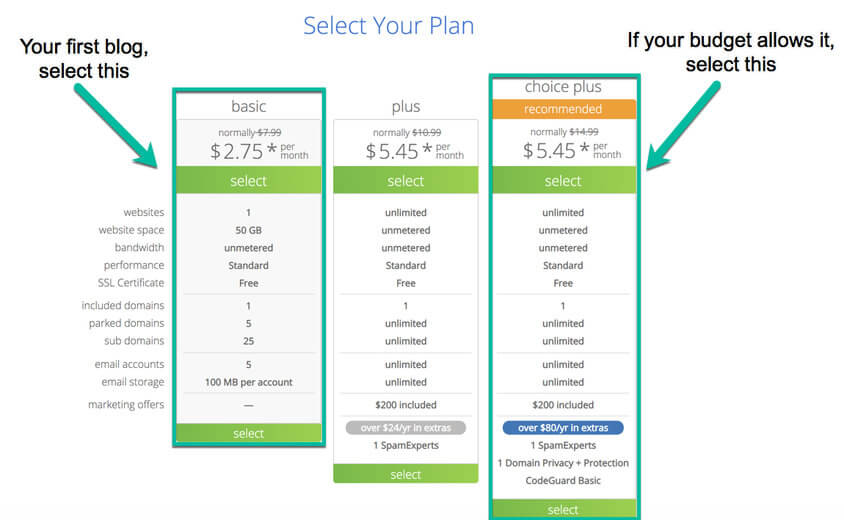
You’ll first have to select your hosting plan. You’ll have four options to choose from, each with different price tags and features. Consider them carefully before you continue.
The basic plan offers you everything you need to get started with your lifestyle blogs. However, we’d recommend Choice Plus if it’s in your budget. The additional features are well worth it.
Choose your domain name

The next step is choosing your domain name. As mentioned, you can use a brand new one, choose one you already own, or come back to it later. Don’t make any rushed decisions as your name will be the first thing your readers will notice.
Register with Bluehost

Once you’re done with the domain name, you’ll be taken to the next step, where you can choose to add/remove additional tools from your cart. Click “Continue” to register with Bluehost.
Pick your hosting package
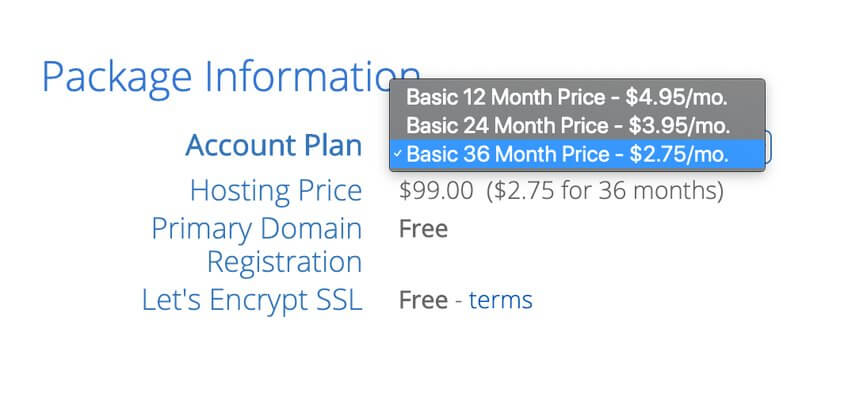
You can choose the length of your hosting package. Your options are 1, 2, or 3 years. While the initial cost of a 1-year plan is the cheapest, you’ll get the best savings with a 3-year plan.
Package extras

If you want any extras with your package, now’s the time to choose them. You can include Domain Privacy Protection for $0.99 a month, which will hide your personal info from the global database. Keep in mind that you can always add these later.
Fill out payment info
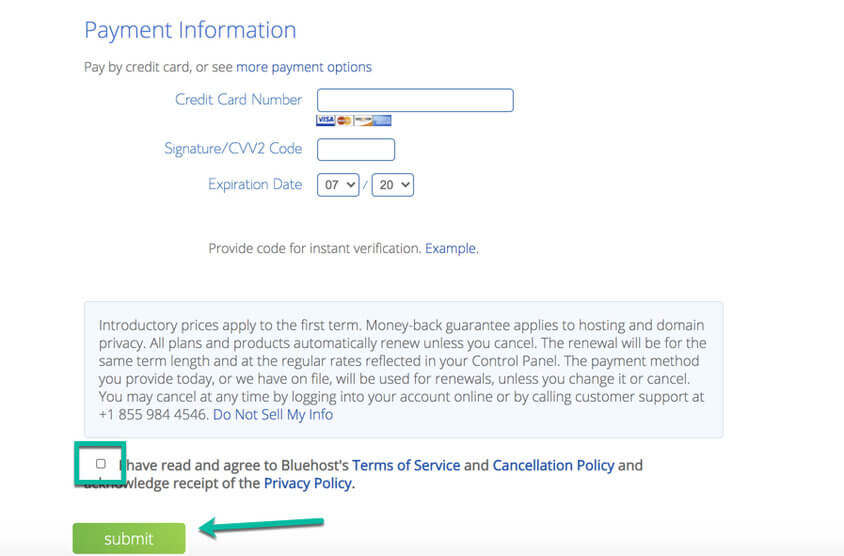
You’ll now have to fill in your billing and payment information. It’s a straightforward process and requires only basic information.
Create your account

Double-check the information you’ve entered, and click on “Purchase Now” to go to the next step. To create your account, you’ll need to follow four steps:
- Go to “Create Your Account”
- Enter your password
- Click on the “Go to login” button
- Enter “Email or Domain Name” and “Password”
That’s it. You’ve created your account, and now you can move on to create your WordPress lifestyle blog.
Launch your WordPress lifestyle blog with Bluehost
Once you’ve logged in to your Bluehost account, you’ll need to follow a few additional steps to create your WordPress blog.
- Answer the three questions about your blog. You’ll need to specify what kind of site you’re creating, what type, and who you’re creating it for.
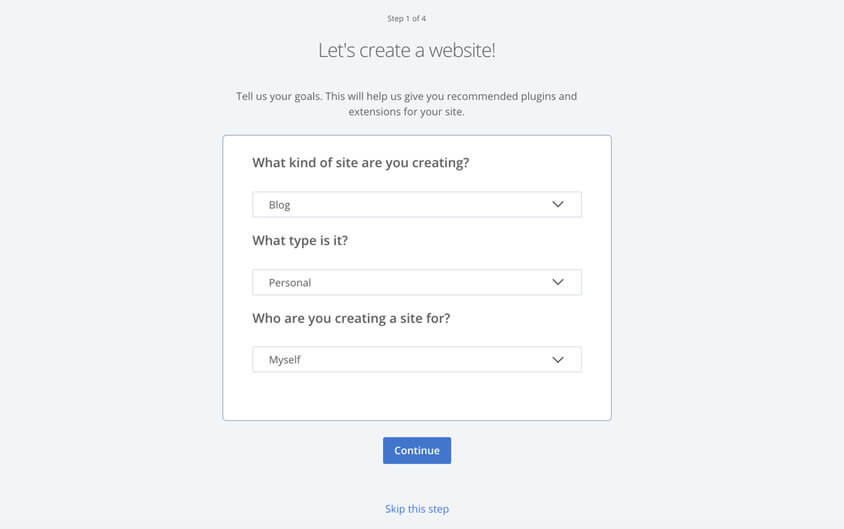
- Pick what features you’d like to add to your site. You’ll have options such as “blog”, “about me”, “store”, “logo”, and “resume”, so select what you need.
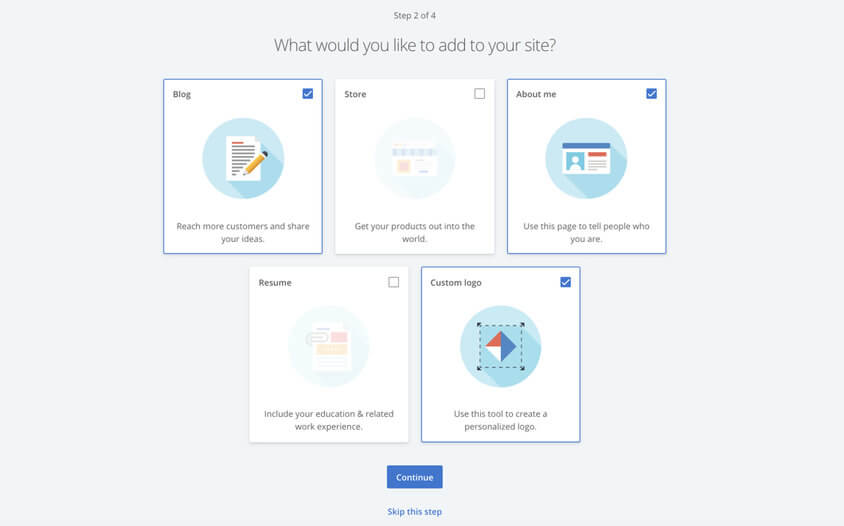
- Fill in additional information about your new site. You can skip this step if you want to, but it can be useful. Answer what you want to name your site, come up with your site’s tagline, and specify how comfortable you are with creating websites.
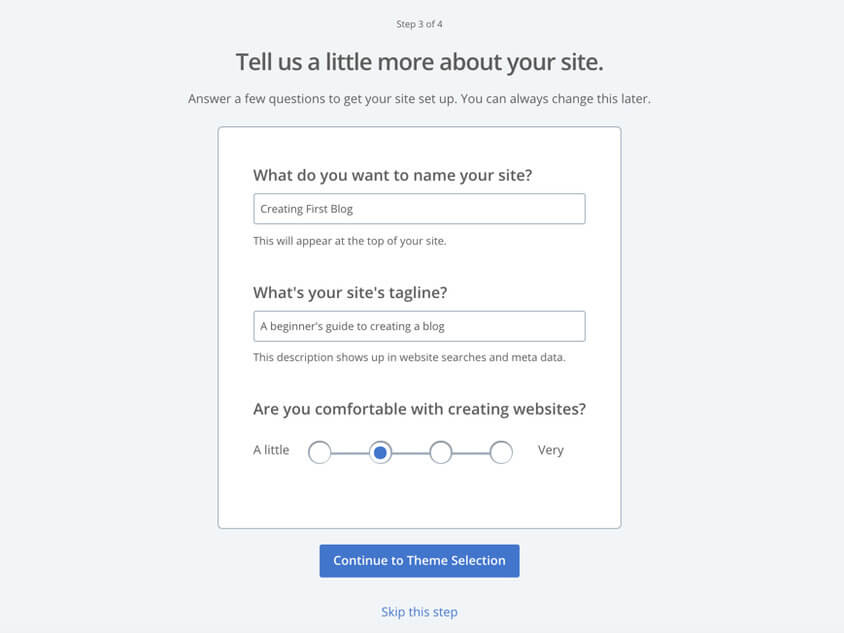
- Finally, you can choose your theme. If you don’t see anything you like, just skip this step. You can always change your theme or go back to it later, so don’t stress.
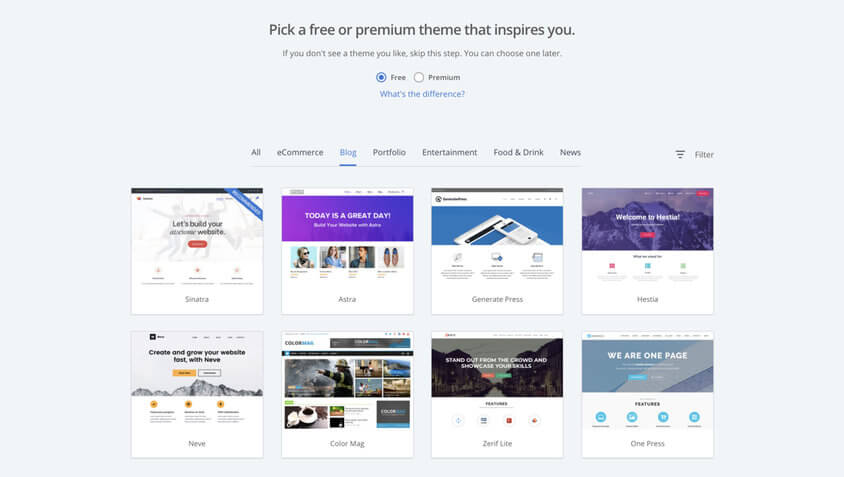
Once you’ve completed (or skipped) these four steps, just click on the “Launch My Site” button.
Congratulations! Your blog is now live, and you can customize and edit it as much as you’d like.
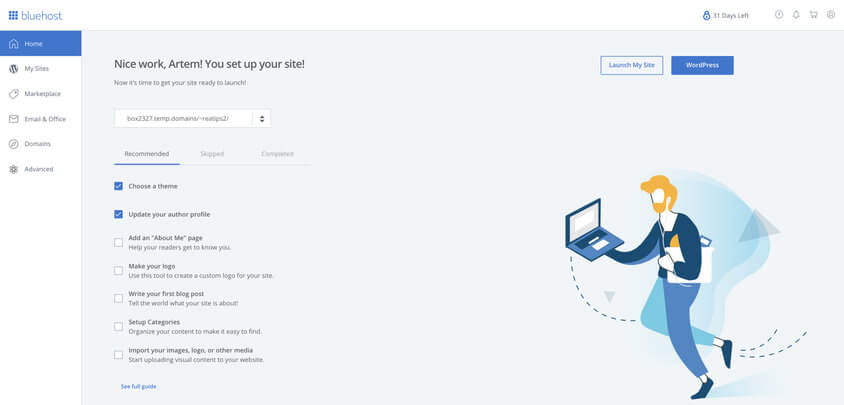
Step #6: Set the theme
If you want to learn how to start a lifestyle blog and make money, you also need to learn how to layout and design a lifestyle blog. You want a visually appealing design that will attract your target readers and reflect your personal preferences.
Luckily, there are thousands of free and paid themes you can choose from on WordPress.org. You’ll find them inside your WordPress dashboard under “Appearance”.
Remember that each theme will customize a bit differently, so it’s a good idea to check out a few different ones. When selecting your theme, always be sure to:
- Preview the theme before activating it
- Check the features it comes with
- Take a look at the ratings
The sheer number of available themes on WordPress.org can be overwhelming, but don’t worry. You can always change the theme later if you want, so it’s not a serious commitment.
What are good WordPress themes for a lifestyle blog?
To help you choose a theme for your lifestyle blogs, we’ve compiled a list of some of the most interesting ones. They come with unique features that can certainly make your blog stand out.
Tripster – Price: $59
Ideal for travel and lifestyle blogs.
- Modern and minimalist design
- Intuitive
- Supports useful plugins
- Features adaptive images
- Cryptocurrency payment options
Pura Vida – Price: $49
A perfect choice for healthy lifestyle blogs.
- Mobile-optimized
- Has WooCommerce integration
- Streamlined layout
- Easily customizable
EnVogue – Price: $49
Stylish and feminine, a great fit for fashion lifestyle blogs.
- Multiple homepage layouts
- Appealing fonts
- Animated page transitions
- Custom social media widgets
Wanderic – Price: $59
Bold and edgy, best suited for travel and adventure blogs.
- User-friendly
- Intuitive interface
- SEO optimized
- Additional widget areas
All of these themes are fully customizable and enable you to appeal to your audiences in a unique way. Check them out, and see whether any of them resonate with you.
Examples of popular lifestyle blogs
Before you get to work and start publishing lifestyle blogs, it’s always a good idea to do some research and find out what others in your niche are doing. This will help you to draw inspiration and develop a distinct brand voice.
We’ve gathered some of the most popular lifestyle blogs across niches, so check them out.
- The EveryGirl – The EveryGirl is a unique lifestyle blog that aims to inspire and encourage women of all backgrounds. On the site, you’ll find educational webinars, finance tips, cooking tips, and more. It stands out as a one-stop-shop for women who need a little bit of guidance about just about anything.
- Say Yes – Say Yes is a family-themed lifestyle blog that covers topics as diverse as home decor and keeping your food fresh for longer. What makes it unique is the friendly and familiar tone that makes you feel like each article was written just for you.
- The Financial Diet – The Financial Diet covers a little bit of everything but mostly focuses on finance and budgeting topics. It’s a place where women can head to learn more about keeping their finances in order and maintaining a better work-life balance.
- A Cup of Jo – This is a family lifestyle blog that shares articles covering motherhood, parenting, traveling, and more. The pieces are interesting and lighthearted, but what makes this blog unique is that Jo regularly engages with her readers in the comment section. She uses comments to stir up discussions, provide additional information, or simply to elaborate on her articles.
Accessorize your blog – add plugins
If there’s one thing your lifestyle blog truly needs, it’s plugins! Without them, your blog will be nothing more than a simple page filled with blocks of text.
You need the right plugins to make your site appealing and useful to readers. You don’t have to include every single plugin you come across, but there are a few essentials. Here are our top five options for all lifestyle blogs:
WordPress Editorial Calendar – Price: Free
Editorial Calendar gives you a clear overview of your posting schedule. It enables you to stay on top of your posts, schedule and manage them, and edit as needed. With a simple drag-and-drop option, you can manage your blog with ease.
Akismet – Price: Free
Akismet is an anti-spam plugin that will help you prevent malicious content on your site. It will filter all comments that look like spam and block the worst ones. You’ll always be able to see a comment’s status history, reveal hidden and misleading links, and more. It’s a must-have for all blogs, not just lifestyle ones.
Jetpack – Price: Free
Jetpack is an essential plugin that overlooks your security and site performance. It prevents unauthorized logins, monitors site downtime, offers two-factor authentication, provides code scanning, and more.
Yoast SEO – Price: Free
This plugin helps you with SEO and aims to improve your blog’s ranking on search engines. It’s the best tool to use to boost your organic marketing. It offers templates for meta titles and descriptions, offers advanced XML sitemap functionality, sets canonical URLs, and offers thorough SEO analysis.
WP Recipe Maker – Price: Free
While not essential for every blog, WP Recipe Maker is an absolute must for food lifestyle blogs. You can also use it for non-food instructions. It’s compatible with Yoast SEO, allows you to include recipe videos, and features easy workflow.
Step #7: Publish and promote
Now, you’re all set to start publishing your posts and attracting audiences. Keep in mind that you won’t get millions of readers overnight. To succeed, you need patience, commitment, and a love for blogging.
Write about the things you love and enjoy doing
It’s essential that you have a great passion for what you’re writing about, primarily because it will be much easier for you to stay committed to something that you love doing. Secondly, readers can spot fake bloggers from a mile away. You could be the best writer on the planet, but they’ll sense if you don’t truly believe in what you’re writing.
So, stay honest to yourself and your audience, and write about the things you love and enjoy doing.
Publish regularly
Consistency is key to succeeding as a lifestyle blogger. Publishing regularly and at a scheduled time will show your professionalism and dedication to your blog. Your readers will know when they can expect to hear from you, and your blog post will become a part of their normal routine.
It doesn’t matter if you want to post once a day or once a week, as long as you stick to your schedule.
Make your blog visually appealing
Everyone has different tastes and styles, so don’t try to please everyone with your blog’s design. It’s important that you enjoy it. Play around with the themes, colors, fonts, and layouts. Have some fun!
Just try to keep the design streamlined. There’s no need to include all of the bells and whistles as that’ll just make your site messy and crammed. Keep it minimalistic, and make sure everything is clearly visible (that means no stretched out images or tiny fonts in a color similar to the background).
Be active on social media
Social media is your go-to place for increasing your reach and gathering more readers, so make use of it. Facebook is a great place to share links to your blog posts, and Instagram and Pinterest are perfect for attracting audiences with your site’s visual appeal.
Post regularly to your social media channels, and engage with your followers in the comment section to establish a meaningful relationship with them.
Collaborate with other bloggers and influencers
The best way to gain exposure is through collaboration with established bloggers and influencers. You can create unique content relevant to your niches to boost readership and gather more loyal followers.
Remember that your collaborations need to be relevant and natural. Find bloggers and influencers you’re compatible with. Again, your audience has a talent for sniffing out when something’s off, so don’t force yourself to work with people you don’t personally like.
Spy on your competition
Checking out the competition is always a good business practice. It’s excellent for gathering inspiration and seeing what type of content your target audience enjoys (and doesn’t).
Examine your competitors’ strengths and weaknesses, and use the information to improve your lifestyle blogs and develop a brand persona that’s unique and attractive.
Step #8: Turn a profit
This final step is usually the most exciting one on your blogging journey. As mentioned earlier, running a blog is a unique experience that you will cherish, but it’s also an excellent way to boost your profits.
Turning a profit with your lifestyle blogs is much easier than you may think, and there are several ways you can do it.
How do lifestyle bloggers get paid?
Of course, you won’t get paid simply for posting engaging blogs and having a large readership. You need to make an effort.
Here are some of the most common methods for earning an income with your lifestyle blogs:
Sell your own products or services
You can use the WooCommerce plugin to sell your own products or services through your blog – it’s the most common way to get paid. Whether it’s handmade accessories to your readers, your own eyeshadow palettes, your own cookbooks, or anything in between, you can easily turn a profit by selling it to your readers.
Sponsored posts
Sponsored posts are essentially paid advertisements. There are two ways advertisers go about them – one, they provide you with a finished piece of content and have you publish it, or two, they have you write the content yourself.
The second option is typically much better. As a blogger, you’ll have your own tone of voice and writing style that your readers will recognize and love. If you publish a piece written by someone else, your audience will likely find out.
Brand ambassadorship
Being a brand ambassador means you’ll have to represent a company you’ve partnered with within a positive light through your lifestyle blogs. It’s your job to increase their brand awareness, spread positive word-of-mouth, and help them to generate more leads.
You can do so by sharing product/service reviews with your audiences, linking to the company’s site in your blog post, wearing their merch in your Instagram posts, and more.
Sell ad space with Google AdSense
The simplest way to earn money through your lifestyle blogs is by using AdSense. The program will analyze your content and audience, then present suitable ads in your ad space. It’s a quick and easy solution for boosting your passive income, but it’s best to combine it with other tactics if you want to really see a difference in your bank account.
Affiliate marketing
Finally, you can make money as a lifestyle blogger by diving into affiliate marketing. Through an affiliate network, you’ll promote others’ products/services (usually by including affiliate links in your lifestyle blogs) and earn a commission.
If your readers use the affiliate links in your blog to buy the said product/service, you earn a percentage of the sales. It’s simple, easy, and quite profitable.
Takeaway
It seems overwhelming, but learning how to start a lifestyle blog is actually a very simple process that you’ll enjoy. There are only a few steps that you need to follow:
- Choose a niche
- Decide on the name
- Set up your blog
- Create a content plan
- Publish regularly
- Turn a profit
- Enjoy the experience!
Running lifestyle blogs is rewarding and exciting. It takes some hard work and patience, and you might encounter a few ups and downs, but it’s well worth it. If you have a passion for lifestyle blogs and feel like you have something to share, there’s no reason not to do it. You’ve got nothing to lose and everything to gain.
So, go ahead, start a blog, and have some fun!
This was a more elaborate blog post on lifestyle blogging. Thanks for this guide. I got a clear idea about the lifestyle blogging.
You’re welcome Shobana. Glad it helps. Let me know if you need anything else!